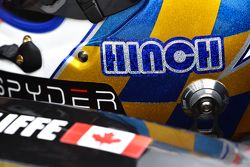How IndyCar's Holmatro Safety Team works
IndyCar and NHRA leading the way in traveling safety

Photo by: Adriano Manocchia







It’s fair to say that IndyCar driver James Hinchcliffe survived that horrible, 125-g crash Monday at Indianapolis Motor Speedway due to the exceptional efforts of the Holmatro Safety Team, which got him out of the car and on the way to the hospital in the team’s usual professional manner.
In fact, in a statement from his hospital room, Hinchcliffe said that himself. "Words can't describe how thankful I am to the Holmatro Safety Team."
It may not be fair to say that only IndyCar’s traveling Holmatro team could have accomplished that. But there are plenty of IndyCar drivers who will tell you that having a trained, professional safety crew that travels from race to race with the series is a gift.
One other major U.S. motorsport series has a similar arrangement. The NHRA’s Safety Safari was the first such crew: It was formed in the 1950s, when the Safety Safari traveled to educate competitors at small dragstrips. A four-man crew made up the original Drag Safari, as it was known then, using a station wagon to pull one small camper-style trailer containing all of the gear needed to stage a drag race, according to the NHRA.
Today, a fleet of trucks pulls a variety of trailers to all NHRA Mello Yello events, bringing customized track- maintenance equipment, electronic equipment, firefighting and other safety apparatuses, and a jet track dryer. The NHRA says the full-time Safety Safari crew arrives at the track Monday of race week to prepare the track. Workers use hand scrapers, blowtorches, a tractor-mounted sweeper, and a large vacuum sweeper to remove excess rubber and groom the surface. The final step is spraying a traction-enhancing compound on the racetrack.
Once the event starts, the crew assists in maintaining the track, but their most obvious job is dealing with emergencies. Compared to other forms of racing, they have two genuine advantages: They don’t deal with more than two race cars and a time, and the track is straight and, and 1000 feet or a quarter of a mile, depending on the class, contained and accessible.
But unlike IndyCar’s Holmatro team, the NHRA crew is dealing with a multitude of different vehicles. IndyCar has only one car – yes, the engines and the body kits are slightly different between the Honda and the Chevrolet, but all the Dallara's important contact points, such as cockpit hardware and, in Hinchcliffe's case, suspension pieces, are the same.
Holmatro a leader
One advantage the IndyCar safety team has is the sponsor – Holmatro. The company was founded in the Netherlands in 1967 to manufacture hydraulic equipment for the shipbuilding industry, and soon added a line of mostly hydraulic safety equipment. Scanning Holmatro’s online safety equipment catalog is impressive – the array of cutters, spreaders and other tools is sobering. Next month, at a global safety convention in Germany, Holmatro is hosting a competition among rescue teams to extricate a “victim” from some brand-new cars, with prizes to the winners totaling 35,000 Euros. All the participaring crews get a lengthy free seminar in the latest techniques and hardware.
According to IndyCar, the Holmatro Safety Team consists of approximately 30 safety personnel with a minimum of 18 attending each event – a trauma physician, an orthopedic physician, 2 paramedics, 12 firefighters/EMTs and 2 registered nurses. Team personnel have an average of 20 years of experience in their respective areas. They travel with four safety vehicles.
“About 75 percent of our team is comprised of civil servants who are officers in their departments, such as captains, lieutenants and a fire chief, which means they have vast amounts of experience managing people and managing ground scenes and incident command,” said Mike Yates, IndyCar’s manager of track safety operations. “Many have bachelor’s degrees in fire science, and we also have people who have gone beyond the scope of their local fire departments by being involved with disaster task force teams.”
The Holmatro Safety Team coordinates the safety personnel staffing each track, including firefighters, ambulance and tow-truck operators and track maintenance crews. An eight-hour instructional course is held at every new venue on the schedule and the team meets with tracks for update sessions before each event.
NASCAR does it differently
NASCAR doesn’t have a dedicated traveling safety team, but does have staffers who work with the local safety and rescue teams that are typically unique to each track. NASCAR insists crews with knowledge of the specific speedways are a benefit, and so far, hasn’t seen the need to supply a full traveling crew like IndyCar or the NHRA.
Drivers sometimes disagree with that philosophy.
“I've tried to get NASCAR to get their own safety crew,” said Sprint Cup team owner, driver and former champion Tony Stewart. “When I ran in IndyCar, you always felt comfortable knowing that if you were in an accident you knew who the people were who were coming to get you out of the car. You knew they were trained properly. I'm praying for the day I show up at the race track and we see a bunch of guys in uniform that are the same guys we see the week before in the previous race and the week before that.”
Stewart said that in 2003.
Be part of Motorsport community
Join the conversationShare Or Save This Story
Subscribe and access Motorsport.com with your ad-blocker.
From Formula 1 to MotoGP we report straight from the paddock because we love our sport, just like you. In order to keep delivering our expert journalism, our website uses advertising. Still, we want to give you the opportunity to enjoy an ad-free and tracker-free website and to continue using your adblocker.


















Top Comments